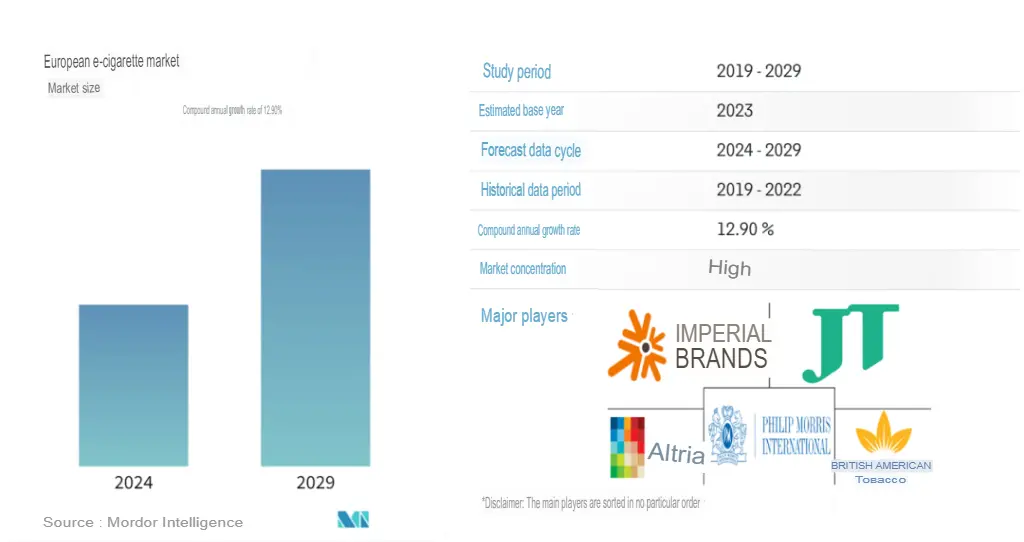The European e-cigarette market is experiencing rapid growth, with a projected compound annual growth rate of 12.90% from 2023 to 2028, increasing from $11.45 billion in 2023 to $21 billion by 2028. Consumer preferences for e-cigarettes are increasing due to their perceived safety compared to traditional cigarettes, as they do not produce tar and carbon monoxide. Countries like the UK and France consider e-cigarettes to be healthier alternatives to traditional tobacco, which has contributed to market growth. Specialized retail stores have become popular channels, but TPD regulations restrict online cross-border sales. Product innovation and mergers are key strategies for major companies. Markets in countries like Austria, Croatia, and the Czech Republic are also growing but face regulatory limitations such as minimum legal purchasing age, advertising restrictions, and bans on public use. The popularity of dual-use e-cigarettes and disposable products is expected to further drive market development.

The e-cigarette market size is projected to grow from $11.45 billion in 2023 to $21 billion in 2028, with a compound annual growth rate of 12.90% during the forecast period (2023-2028).
The European e-cigarette market is experiencing robust growth due to increasing consumer interest. E-cigarettes utilize a heating element (vaporizer) for combustion of liquid mixtures, a mouthpiece for inhalation, and a reservoir for containing liquid solutions. This means e-cigarettes are perceived as safer alternatives to traditional cigarettes because they do not burn tobacco, which produces tar and carbon monoxide, thus driving demand for e-cigarettes in Europe. Positive marketing of e-cigarettes in the European region has led to a substantial increase in consumers opting for these devices, especially among young adults and adolescents.
Countries like the UK and France do not endorse the research of the World Health Organization and still consider e-cigarettes less harmful to health than traditional tobacco. Therefore, the European e-cigarette market is growing as consumers increasingly use e-cigarettes for health reasons and as expected results are observed in attempts to quit smoking/reduce the use of traditional/combustible cigarettes. Despite concerns from some medical professionals about long-term e-cigarette use, the low-risk factor compared to traditional/combustible cigarettes is driving growth in the region’s market.
Observationally, tobacco shops and e-cigarette stores are the most popular channels. The enactment of the EU Tobacco Products Directive (TPD) in 2014 has impacted online retail channels, with some countries banning cross-border remote sales of e-cigarettes.
European E-cigarette Market Trends
Rise of dual-use e-cigarettes
To reduce the use of traditional/combustible cigarettes, consumers in the region are increasingly using e-cigarettes simultaneously. Additionally, as e-cigarettes mimic the smoking experience of traditional/combustible cigarettes, consumers are increasingly using them to satisfy their nicotine dependence. E-cigarettes do not produce the tar found in traditional cigarettes, which is a major cause of lung cancer.
Furthermore, since these products are available in nicotine and non-nicotine forms, most people consider them to be better alternatives. As a result, the product is gaining mainstream recognition, with more and more smokers trying and accepting e-cigarettes as alternatives to tobacco.

Research conducted by the UK Department of Health and Social Care’s Health Improvement and Disparities Office (OHID) found that disposable e-cigarette products are becoming increasingly popular among adult e-cigarette users, with the percentage of adult e-cigarette users using disposable e-cigarette products rising from 15.2% in 2022 to 17.4% in 2021, indicating a surge in popularity. Due to e-cigarettes being considered safer, consumption among young people in the European region is increasing.
Research conducted by the UK Department of Health and Social Care’s OHID found that from 2020 to 2021, attempts to quit smoking involving e-cigarette products had a higher success rate (64.9%) compared to attempts not involving e-cigarette products (58.6%).
This dual use significantly increases the number of e-cigarette users in the region and is expected to drive market development during the forecast period. Observationally, dual users typically gradually reduce their use of traditional/combustible cigarettes over time, increasing the likelihood of repeat purchases of e-cigarettes in the region.
Overview of the European E-cigarette Industry
The European e-cigarette market has consolidated, with several well-known companies dominating most of the market share. Key strategies adopted by major players include product innovation and mergers.
Major players are investing in research and development to develop and launch new innovative products to meet the growing demand for new products from consumers worldwide. As the number of health-conscious consumers globally continues to increase, major players are adopting various strategies to attract consumers’ attention by introducing products with new technological advancements.
Increased market concentration and increased advertising expenses are also intensifying competition. Additionally, players are constantly introducing new products to maintain and strengthen their market positions. Some of the major players in the market include British American Tobacco, Philip Morris International, Altria Group Inc., Imperial Brands PLC, and Japan Tobacco Inc.
European E-cigarette Market Dynamics
March 2023: Aquios Labs, a UK company, announced a new innovation involving water-based technology and collaborated with Innokin Technology to launch a commercial product, offering smokers a better smoking experience.
February 2023: Imperial Brands announced the launch of the highly anticipated Pulze heating tobacco device upgrade, demonstrating the company’s commitment to innovation and the development of potentially low-risk products. Pulze 2.0 impresses with its compact all-in-one design and impressive feature of providing 25 or more sessions on a single charge, taking convenience to a new level. To kick off the launch, the product was first introduced in four major markets: Italy, Poland, the Czech Republic, and Greece.
March 2022: BAT announced the testing launch of its new disposable e-cigarette called Vuse Go in the UK. The company claims it has nine flavors, including creamy tobacco, mint ice, and various fruit flavors.
November 2021: Imperial Blue launched heated tobacco products in the Czech Republic. The company has invested in heated tobacco products in several major European markets as part of its new strategy to build targeted and sustainable next-generation product businesses.
PART/1 History of the Austrian E-cigarette Market
• In Austria, the e-cigarette market’s revenue is expected to reach $221.2 million by 2024.
• The market is expected to grow at an annual rate of 1.96% (compound annual growth rate from 2024 to 2028).
• Compared to other countries globally, the US leads with revenue of $8.827 billion in 2024.
• With more smokers seeking healthier alternatives to traditional tobacco products, Austria’s e-cigarette market is thriving.
Introduction to Austria (Around 2010): E-cigarettes were introduced to Austria around 2010, following their emergence as a new technology in the early 2000s. These new devices were seen as healthier alternatives to traditional tobacco.
Regulatory Constraints (Since 2015): Like many European countries, Austria began imposing regulations on the sale and use of e-cigarette devices around 2015, following the implementation of the European Tobacco Products Directive (TPD).
Growth and Impact (2015-Present): Despite facing some regulatory challenges, the popularity of e-cigarettes in Austria has gradually increased since 2015. A study in 2019 indicated that there were approximately 380,
000 regular e-cigarette users among Austrian adults.
Current Market (Present): Today, Austria’s e-cigarette market continues to evolve. Some retailers have even begun selling online, offering a variety of e-liquid flavors. However, like in other countries, e-cigarette use has raised some concerns among young people and adolescents.
The Austrian government has indeed established regulations on the sale and use of e-cigarettes.
1. Minimum Legal Age: In Austria, only those aged 16 and above can purchase and use e-cigarettes. This aligns with the legal purchasing age for traditional tobacco products.
2. Advertising Restrictions: Austria has regulations on e-cigarette advertising. Public media, including television, radio, and newspapers, are prohibited from advertising e-cigarettes. Additionally, advertising on the internet is also restricted.
3. Packaging and Labeling: E-cigarette products in Austria must meet specific packaging and labeling requirements, including warning labels and nicotine content information.
4. Use in Public Places: Using e-cigarettes is prohibited in some public places in Austria, such as public transportation, restaurants, and offices.
5. European Tobacco Products Directive: As a member of the European Union, Austria’s e-cigarette regulations must comply with the European Tobacco Products Directive (TPD).
PART/2 History of the E-cigarette Market in Croatia
• In Croatia, the e-cigarette market’s revenue is projected to reach $17.4 million by 2024.
• The market is expected to grow at a rate of 1.48% annually (compound annual growth rate from 2024 to 2028).
• Compared globally, the US has the highest revenue in this field, reaching $8.827 billion in 2024.
• In Croatia, the e-cigarette market is experiencing rapid growth as more young people begin using e-cigarettes as a popular alternative to smoking.
Croatia, like most European countries, has regulations on the sale and use of e-cigarettes. However, there may be some differences in the interpretation of specific regulations. Generally, the Croatian government’s stance on the sale and use of e-cigarettes is similar to its stance on traditional tobacco products. For example, those under 18 are prohibited from purchasing and using e-cigarettes.
In many cases, e-cigarettes cannot be used in public places, consistent with Croatia’s domestic regulations on smoking. Additionally, the sale of e-liquids, or what we commonly call vape juice, containing nicotine is restricted, especially online sales.
The Croatian government has restrictions on e-cigarette advertising and promotion. This is similar to many other European countries and complies with EU directives.
Specifically, under the EU’s Tobacco Products Directive, member states are required to ban all forms of tobacco product advertising and promotion, including e-cigarettes. This includes advertising on television, radio, and the internet. Additionally, indirectly promoting e-cigarettes through sponsorship activities is also prohibited unless such products have obtained relevant pharmaceutical permits.
PART/3 History of the E-cigarette Market in the Czech Republic
1. In the Czech Republic, the e-cigarette market’s revenue is expected to reach $110.4 million by 2024.
2. The market is expected to grow at a rate of 2.00% annually (compound annual growth rate from 2024 to 2028).
3. Compared globally, the US has the highest revenue in this field, reaching $8.827 billion in 2024.
In the Czech Republic, as more smokers turn to e-cigarettes as a healthier alternative, the popularity of the e-cigarette market is skyrocketing.
Since 2006, the overall smoking rate in the Czech Republic has increased. Currently, 31.5% of adults in the Czech Republic smoke, up from 29% in 2006. This means there are currently around 2.8 million smokers in the country. 35.6% are male smokers, while the figure for female smokers is 27.3%.
Nicotine e-cigarettes (e-cigarettes) are legal in the Czech Republic, where there are 272,500 e-cigarette users, with an adult e-cigarette prevalence rate of 3.02%. There are requirements to ensure that e-cigarette packaging contains health warnings, can only be sold to those aged 18 and over, and there are legal restrictions on the use of e-cigarettes in public places.
Nicotine replacement therapy (NRT) can be sold on the market without a prescription and can be purchased at pharmacies. The NRT market in the Czech Republic is worth EUR 6.2 million.
The Czech Republic complies with the European Union Tobacco Products Directive (TPD) (2014). Regulation 37/2017 regulates e-cigarettes containing nicotine. The sale and use of e-cigarettes are legal in the Czech Republic, with restrictions on their use only in a few public places such as hospitals, schools, shopping malls, and public transport. Cafés, restaurants, and bars, among other leisure venues, are reportedly still allowed to use e-cigarettes. E-cigarettes are not taxed, and cross-border sales are legal.
Please note that the translation provided above is a direct translation from Chinese to English, and some sentences may require further editing for clarity and coherence.












